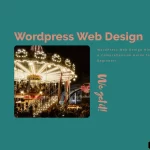The realm of web design is one that continues to evolve incessantly. To stay at the top of the competition, beginner or enthusiast web designers must ensure they are constantly educated and inspired.
In this comprehensive guide we’ll take a look at some of the best web design inspiration sites that can ensure you of an uninterrupted flow of inspiration and will also aid you in creating a website that is a real looker. From some really great examples of color palettes to experimentation with layout ideas, we will show you everything you need to make your web design skills better by a ton. So a plan to aspire and gain perspective for a fresher web design will help you in your career.
Web design inspiration can be gained from the internet or through various other sources. Let me tell you some ways to spark your creativity and actually implement them.
- Browse designs on online platforms: Behance, Dribbble, and Awwwards are some of the many platforms that enable designers to display their creativities to the entire world. On these pages, you will get to see a lot of hero images and some of the most unusual typographies you’ve ever seen. Also, these pages would have eye magnetizing button styles. Exploring design spaces.
- Go to Pinterest or Instagram pages: Pinterest and Instagram are awash with colorful imagery and could be instrumental in bringing off the look. Finding colors and materials and exploring ways to convey these through design such as combining color palettes, icon sets and gallery sliders are some of the steps in the design process.
- Inspiring design: Make use of the web to view and analyze the websites of the best companies encompassing top-level navigation, mobile responsiveness, and other user-friendly features.
- Participate in design conferences and workshops: These occasions grant you the opportunity to meet new people who might help you with your journey of mastering the best techniques and concepts in the areas like parallax scrolling and animation effects.
- Experience the real thing: Actually get outside and walk around the city to find colors and compositions that aren’t in textbooks. Imagine pulling over the car and photographing or sketching a beautiful statue, a fun building, or a neat bridge.
- Approach web design self-study like you love it: Learning web design on your own is a challenging but highly satisfying adventure. Below is a self-study plan that you can use to get started:
- Start with the basics: Be it by working on practicing languages like HTML, CSS, and JavaScript. You are in the process of learning the web designing framework. Online learning places such as Codecademy and freeCodeCamp offer some of the best courses that you can apply for to learn about this.
- Learn about design: The subjects like color theory, typography, and composition will help you understand design basics and assist you in creating theme templates and perfecting web page designs.
- Know your output and tools: Utilize applications such as Adobe XD, Figma, and Sketch which will allow you to make some layout ideas up and demonstration of the entire design as if it were the finished product.
- Practice mobile design: Visit your web pages on your devices to check their responsiveness. According to research, this technique is the most effective in the mobile-first world.
- Experiment with advanced tools: After mastering the basics, you can venture into such areas as grid systems, parallax scrolling, and animation effects.
- Show your work which might not be perfect: You can take it to the next level by engaging yourself with personal and self-discovery projects or asking for a redesign of already made websites. By doing so, you scrutinize more profound ideas such as responsive design and grid system.
- Get critique online: Join online co-design collaborations and let them assess your work. The experienced people will give you suggestions about your work and advise you concerning typography styles and color palettes.
Sources of Inspiration for Web Designers
Any designer has his/her mind map so to speak which are the primary sources of inspiration that one keeps going to. Here are some of the popular ones that you can look up and include in your next designs:
- The art of Nature: Mother Nature, never tire of its endless array of new and organic colors, and shapes as such will certainly inspire you in terms of layout ideas and animation effects.
- Art galleries and museums: The ancient or new forms of arts in both cases can be compared to stunning typography styles and amazing hero images.
- Our fights: For human creativity and food production to be produced, certain building designs are the muse which can lead to the creation of grid systems, responsive designs, and even parallax effects.
- Art and fashion: Fashion styles have been known to influence color palettes and button styles in web designs all over the web.
- People experiences: Think of good and bad experiences with mobile apps and websites as a starting point and find out the elements that are most in need of repair like navigation menus and landing pages.
- Consumer stock photos: Check out Unsplash and visit a site like Pexels to find some stock photos for yourself. Sexy hero images and innovative button styles are the main items found on this hub.
- Design strategies: Design blogs and especially podcasts are a must-read design blogs and a source of knowledge podcasts to live on the trends and techniques.
Top Websites for Web Design Inspiration
These websites are worth visiting when you need an instant stream of fresh ideas for your work:
- The one about Behance: Behance is a design platform, which encompasses different types of designs including web design. It is a great source for layout ideas and typography styles.
- Dribble: Say Dribbling if design is your endnote and Instagram is the way. It will provide you with swathe after swathe of color palettes, icon sets, and much button styles along with playful design ploys which you will most certainly want to use as inspiration in your projects. Spend significant time consuming photography and the visual arts at galleries and museums around the globe.
- Awwwards: At Awwwards you get to see the newest and the best website designs. You are going to have a hard time picking the one that illustrates most creatively animation effects and parallax scrolling.
- CSS Design Awards: CSSDA allows the users to vote for the most outstanding designs. It’s also a good destination to evaluate the latest and greatest among navigation menus and responsive designs.
- Muzli: Muzli refers to one of the Chrome extensions that give a daily presentation of the emerging design concepts and developments in the industry. This is the best place to get hero images, landing pages, and gallery sliders.
- Siteinspire: Online sources of various web and application designs make it easier for someone with layout ideas and theme templates to experiment with designs he/she never thought of. It is indeed the best information which daily provides you with a therapeutic dose of visual dopamine.
- Codrops: This place has in store for you some great designs that also come with tutorials and experiments, which actually represent the tips for learning animation effects and parallax scrolling. And you will certainly need lighter topics like how to designs for X.
Gaining Experience in Web Design
However, apart from building a strongly attractive and formidable portfolio, inexperienced web designers also require a practical experience to become professionals. It is more or less connected to the time factor, which is the following items you can use for getting that experience:
- Freelance your skills: New designers such as yourself can take a step by accepting small jobs from platforms like Upwork and Fiverr. These jobs can be spark plugs of your first responsive designs and theme templates.
- Pro bono work: Try to contribute your work to community projects as a volunteer. This is an opportunity for you to gain experience in creating layout ideas and navigation menus thereby modifying your portfolio.
- Projects Just-For-Yourself: You can easily create a blog or portfolio site as the first one to show what you know. This way you will be hands-on was animation effects and parallax scrolling.
- OSS Contributions: On the website GitHub, numerous projects related to open-source web design are available. You can use such collaborations to hone your grid systems and the sharing of your source code.
- Participate in design problems: One of the most positive learning aspects that the platform “Daily UI” has for web designers is the design challenge. Here, you can try a combination of colors, fonts and much more with your color palettes, typography styles, and button styles.
- Internships: Make it easier for the students to know what they have learned by working as an intern at either an educational institute or a real company. The projects could be related to web design and would provide great responsive designs and such which can be shown to clients.
- Online classes and certificates: The online learning platforms such as Coursera and Udacity mostly propose a list of web design courses which you can apply for. They are designed to enable everyone who completes the courses to acquire the skills and knowledge that are required to be competitive in the workplace.
Taking the first steps in training to do web design takes patience and sometimes giving up some sleep. Always be curious and try to learn from your mistakes and successes. For this endeavor, with constant learning and inclination to be the best you can be, you will be able to construct admirable websites and the most ardent designers in the community will be surprised;



